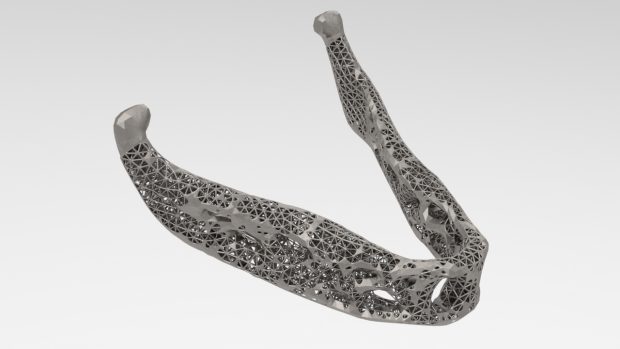
Inspire 2018 debuts functionality that enables design engineers to generate optimized lattice as well as mixed solid-lattice structures that can be exported for 3D printing readily. Shown here is a mixed solid-lattice optimization of a prosthetic human jaw. Image courtesy of Altair Engineering Inc.
February 7, 2018

The formal description of Altair's Inspire is that it's a generative design/topology optimization and rapid simulation solution for creating and investigating structurally efficient concepts quickly. The taproom description is that it can help you create strong, lightweight parts with minimal ado. But don't take it from me. From the links at the end of today's Editor's Pick of the Week write-up, watch how it operates, get a trial license and develop your own description.
Backdrop: You can use Inspire from a design project's “digital napkin” stage, to take a new look at a trusty old design or in-between. You can make and simulate dynamic systems to resolve loads. You can simulate competing ideas for, say, static loads and buckling. To meet lightweighting targets, you can optimize designs that consider both the intended machine and materials. And you don't have to be a simulation savant, nor is Inspire only for do-bees at large outfits.
 Inspire 2018 debuts functionality that enables design engineers to generate optimized lattice as well as mixed solid-lattice structures that can be exported for 3D printing readily. Shown here is a mixed solid-lattice optimization of a prosthetic human jaw. Image courtesy of Altair Engineering Inc.
Inspire 2018 debuts functionality that enables design engineers to generate optimized lattice as well as mixed solid-lattice structures that can be exported for 3D printing readily. Shown here is a mixed solid-lattice optimization of a prosthetic human jaw. Image courtesy of Altair Engineering Inc.Inspire 2018 is just out. It has lots of goodies for making, simulating and optimizing additive manufacturing designs. We'll focus on two of the latter, but there's much more going on with this release. For example, it has a new Profile Editor for motors and actuators as well as a new Load Cases Table for managing boundary conditions.
Key enhancements for simulation-driven additive manufacturing design include optimized lattice structures and new Overhang Shape Control tools.
Inspire 2018 debuts tools to generate optimized lattice structures as well as mixed solid-lattice structures. From a video, they look simple to use. Two neat takeaways here. One, this can help you achieve lightweighting goals while maintaining stress constraints. Second, you can optimize the entire enchilada or optimize specific sections of a model if you need to. Your lattice work is STL-exportable for 3D printing.
Overhang Shape Controls is not a euphemism for some diet plan, although it reduces things. What these controls do is help you reduce overhangs and create more self-supporting structures—all within material-specific constraints.
Today's Editor's Pick of the Week write-up zips through this and more, but hit the links at the end for the real lowdown. Use the first link if Inspire is new to you. If you're using it already, the second link goes to what's new in Inspire 2018. Sixteen short videos are there as well as a link to an upcoming live webinar. Inspire 2018 seems both easy to use and highly useful.
Thanks, Pal. – Lockwood
Anthony J. Lockwood
Editor at Large, DE
More Altair Coverage
Subscribe to our FREE magazine, FREE email newsletters or both!
About the Author
Anthony J. Lockwood is Digital Engineering’s founding editor. He is now retired. Contact him via [email protected].
Follow DE






